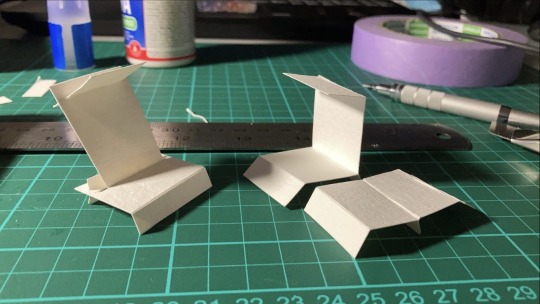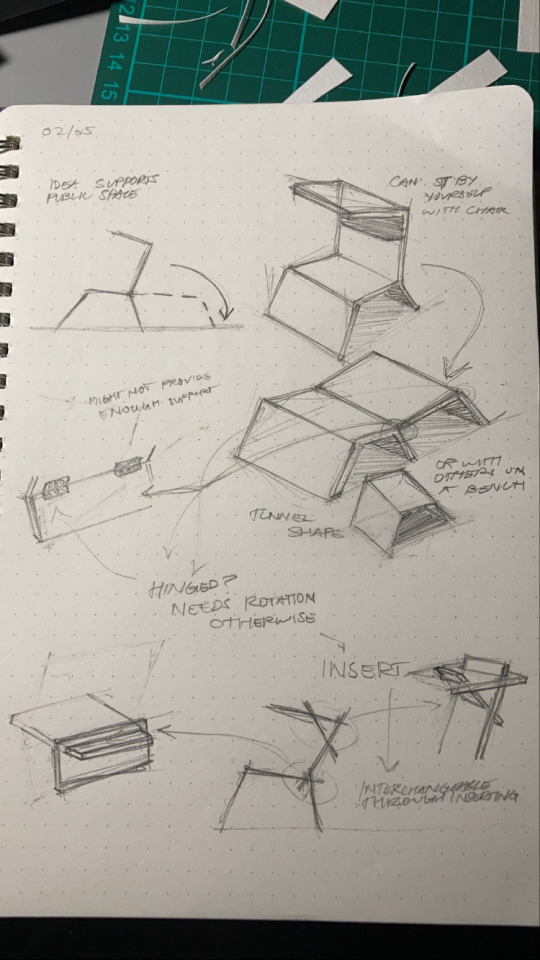Text

Development 3 - Rotated the Legs
Side legs allows for more comfortability (being able to tuck legs in), stability and looks better overall.
0 notes
Text

Development 1 - Form and Simplification
I found myself exploring ways on how I can make my cushion more efficiently. In this development, I looked at changing the back rest angle and which way this component flips over. The original design had the rest going down to the rear end. This added complications with stability and with having to flip the shade component 180 degrees to accomplish its second purpose as a leg. By changing the flipping direction of the back rest towards the front end, it allows me keep the shade part rigid and also lets me use hinges or shelf brackets as a way to add the rotational component to the cushion.
0 notes
Text
Tutor Feedback (Emily)
The main things I was worried about were addressed thoroughly during the feedback session.
I will need to narrow down what narrative drives my project. In a nutshell, Emily told me that less is better.
Another issue I was concerned about was materiality. As I thought, acrylic would need to be really thick in order for the cushion to work. This will end up being heavy and expensive thus, I will opt out with using acrylic and will work with plywood instead.
Plywood is fairly cheap for a project like this and can be obtained in different thicknesses easily. It can also come treated which is more suitable for outdoor use.
0 notes
Text




Book Binding
Our presentation requires us to create a booklet and on Monday last week, we learnt a few different techniques in regards to binding a booklet (shown above).
0 notes
Text




Cushion Ideations
Here are some other potential forms that my cushion may take. I might look at expanding a few more of the designs to see what can work best in reflecting Albert Park’s rich context and history.
0 notes
Text

More Exploration Through Modelling
The very first idea appears to be the more viable option as the design of using panels encounters more issues in the long run. One of these were stability as the materials may not provide enough support for the load that it holds. A few tweaks and redesigns will be done to see what can work with that design.
The design of a folding chair into a bench looks minimal, usable and very practical. When folded down, it also takes on the form of a linear arch which can help to represent the context of the long forgotten Albert Park Tunnels buried beneath the park.

0 notes
Text

Exploring Fabrication Techniques
The idea behind this design is to create a chair that provides shade for one person or a bench for multiple people. This helps to expand on the idea of public space as people will either want to sit by themselves or with others. By giving them an option, it gives the users freedom whether they want to enjoy the shade by themselves or socialise with other people.
This idea seems slightly difficult to execute but it can be possible through folding using hinges or locking brackets. The problem with using normal hinges is that they will not lock in place, but they do provide the rotation required for this idea to work. A shelf bracket can also be used and may end up being the better idea of the two as they usually lock in certain places and also provides some form of rotation.
A second method further explores the idea of public space by letting the public create their own chair. By using removable and insertable panels instead of binding the materials together, users will be able to build their own chair. Some constraints I found with this design however, were stability and the amount of ‘seating’ you can actually create.
0 notes
Text
Murphy's Law
This law states that "Anything that can go wrong, will go wrong."
Surely enough, things went wrong in the tree scale model activity for me. Although having planned ahead of time, it seemed as if the future that 'I planned for' was not as reliable as I thought it would be.
When Emily told me that I would learn twice as much as everyone else, I figured that she did not mean it literally according to the activity, but more towards the process of fabricating anything. It did make me realise that the more mistakes I make, the better the final result becomes. This is obviously not always applicable to everything, but it sends the message that mistakes are not necessarily always a bad thing. By coming across flaws, I will find out what improvements can be made towards a product.
This is how I expect my fabrication process to go. I don't think I will be able to replicate the cushion I fully envisioned in one go knowing how much of an iterative process it will become. Throughout the process, adaptations need to be made considering costs, material availability, durability, appearance, comfort etc.
Things can go wrong, and I hope that they do so I can figure out how to perfect the processes in creating the cushion I envision.
0 notes








